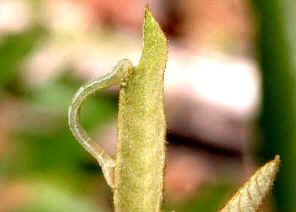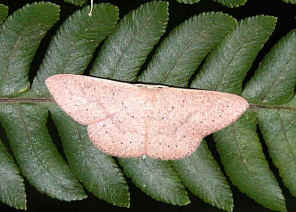Looper Moths - Family Geometridae
Most of the Caterpillars in family GEOMETRIDAE only have one or two pair of prolegs. The caterpillars move with curving their bodies into loops. This is why they commonly called Loopers. They are also known as Inch Worms because they apparently measuring off one inch at a time as they move. Some of them are called Twig Caterpillars because their resting posture look like a twig.
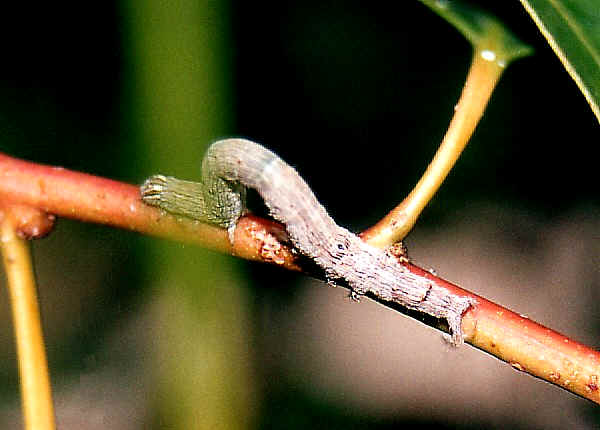
The
GEOMETRIDAE caterpillars
are usually hairless and with slender body. They are well
camouflaged in green or brown in colour. Most of them feed on leaf and active
during the day.
Most of them are easy to rear. The GEOMETRIDAE usually
pupate in plant materials or in the soil in a flimsy cocoon.
Their adults are medium to large size. Most of the
adult moths have camouflaged wing patterns. These patterns are usually wavy
lines extend across both fore and hind wings. These moths rest with a standard
posture, holding wings outspread and tightly pressed against the surface
on which they are sitting. This eliminates the shadow as well as the wings
outline for a better camouflaged posture. Most GEOMETRIDAE moths are active at
night.
- Black Inch Worm
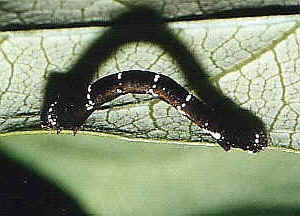
- Hyposidra talaca, Subfamily ENNOMINAE, length 20mm
- They are known as Inch Worms because their caterpillars apparently measuring off one inch at a time as they move. The caterpillars are black in colour with white dots. Their adult moths are brown in colour, with pointed wings.
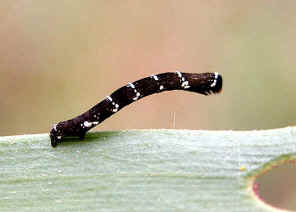
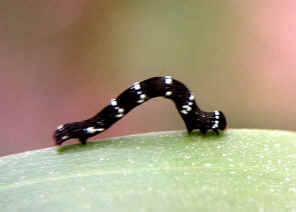
- Notice this caterpillar have only one pair of prolegs, while most caterpillars in other families have four pairs.
- Twig Caterpillar
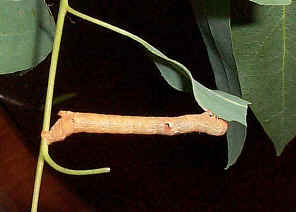
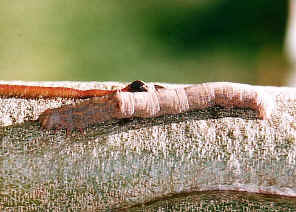
- Ectropis excursaria, Subfamily ENNOMINAE, 40mm feeding on gum tree leaf.
- The caterpillar resting posture looks like a twig. It is pale brown in colour with black and white mark about halfway along each side. The caterpillar feeds on a wide variety of plants including gum tree. They pupa in soil. The moth is grey to light brown in colour with wavy lines across wings.
- Pink Bellied Moth
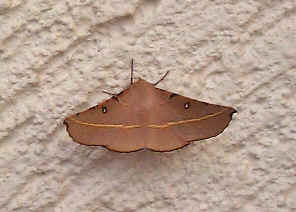
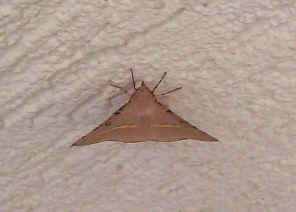
- Oenochroma vinaria, subfamily OENOCHROMINAE, wingspan 40mm
- This moth is pink in colour, found come to our house at one summer night. The colour of this moths can be brown to pink within species, resemble a dry gum leaf. All of them have recurved wingtips and a yellow line across each wing. This moths have many common names such as Hakea Moths, Grevillea Moths and Win-coloured Moths. Their caterpillars are brown in colour, have a large black band with white dots.
- Triangular moth
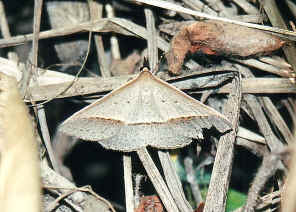
- Epidesmia sp., subfamily OENOCHROMINAE, wings span 40mm,
- Their caterpillars feed on gum tree leaves, brown in colour with some white spots and resembles twig. The moths like to rest on ground among dry plants materials..
- Looper Caterpillar mimic fallen bark
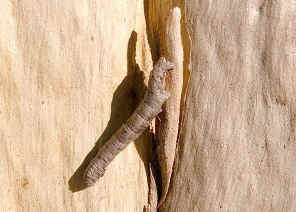
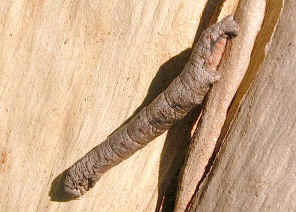
- Gastrophora henricaria., subfamily OENOCHROMINAE, length 60mm
- Found on gum tree trunk near the ground during later summer.
- Bizarre Lopper Moth I
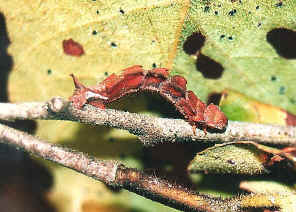
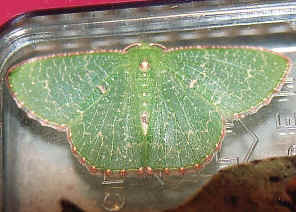
- Anisozyga metaspila, Subfamily GEOMETRINAE, caterpillar length 20mm, adult male, wing span 30mm
- We found this caterpillar on early summer. This caterpillar camouflages as part of the stem. We only know it was a looper caterpillar when it start to walk away. The caterpillar is brown in colour. It body surface is covered with small hard round bumps. The adult moth is basically green, with lacy white spots on the wings. More pictures and information please find in this page.
- Bizarre Lopper Moth II
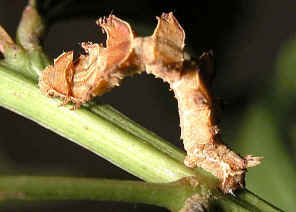
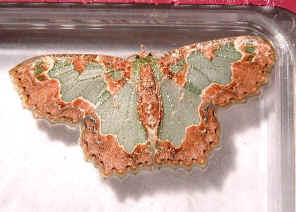
- Anisozyga pieroides, Subfamily GEOMETRINAE, caterpillar length 20mm, adult male, wing span 30mm
- The small caterpillar was found on a Acacia leaf. The picture show a female Bizarre Lopper Moth. It is green in colour with brown wing edges. The male moth is green and white in colour, look quit different. More pictures and information please click on here.
- Common Looper Moth
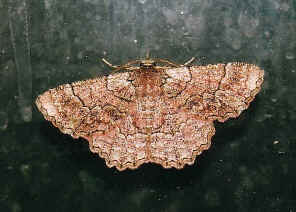
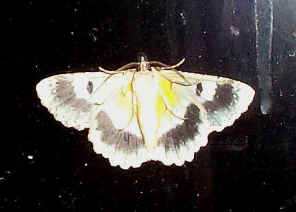
- Hypodoxa muscosaria, Subfamily GEOMETRINAE, wingspan 40mm
- The about pictures taken in mid-winter, the moth rest on our window glass in a cool night. The Bottom view is quite different from the top view. There are the dark patterns along the wings edges. Their caterpillar is green in colour resemble plants stem. Most information and pictures in this page.
- Looper Moth
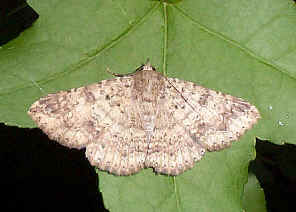
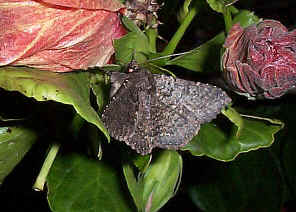
- ? sp. Subfamily GEOMETRINAE, wingspan 40mm
- The moth sit with a standard posture, holding wings spread out flat. We found that there are dark brown moths and light brown moths with the same patterns in our backyard. We think they could be the same species, but not so sure.
- Geometrid Moth
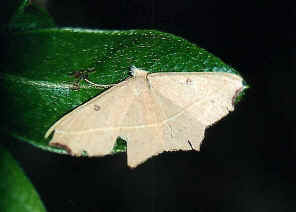
- Gnamptoloma aventiaria, wing span 30mm, subfamily STERRHINAE,
- The moths are reddish in colour with a "burn mark" on forewings. There is a yellow line across wings. Each forewing has a dark spot. Their caterpillars are green and brown in colour, moving in typical looper fashion.
Questions for Discussion
How the caterpillars run away from their predators? Why we sometimes see a Looper Caterpillar hanging from a silk in mid-air?
Most caterpillars move slowly. If they have to run away from their predators, the most effective way is to drop onto the ground. However, most caterpillars, beside just dropping, they evolved different ways to enhance their way of escape.
- Looper Caterpillar that Bungee-Jumps
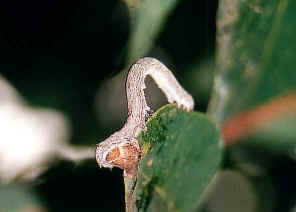
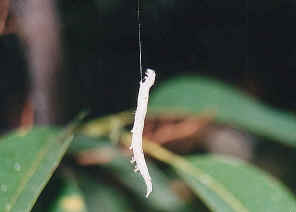
- We find that for the Looper caterpillars that live on trees, they use a very smart way to escape from predators. Like the Looper in above photos, when disturbed, it drop to the ground and disappear form predator's eye-sight. When we check carefully, instead of just doing a simple jump, the Looper made a Bungee Jump. It jumped with a safety line, the silk, attached to its body. After jumping, it was hanging in the mid-air. After a minute or so, it climbed via the silk back to the same place easily.
- There is a lot of advantages on this Bungee-Jump. If the caterpillar just drop to the ground, the ground is sure not a safe place for the caterpillar. Also it is very hard for the caterpillar to climb back up to the tree. The worst is, if it drop to the ground, the predator may follow and find it.
- Next time when you see a Looper, try to induce a Bungee Jump. This is fun to watch.
- Caterpillar that drops and curves
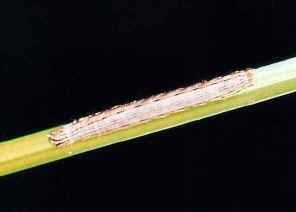
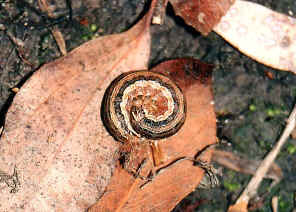
- For some other caterpillars, such as the one in the above pictures, they are not living on a tree. They live on grass. The Bungee Jump escape methods may not be practical. Instead, this caterpillar drop to the ground and curve its body into a round shape.
- The curved caterpillar looked completely different so the predator may not recognize it on the ground. Later when the danger has gone, it is not too difficult for the caterpillar to climb back onto the grass.
